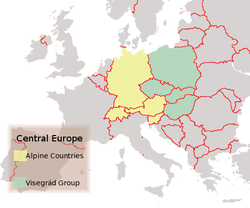Alpine countries
|
|
The Alpine countries, sometimes called Alpine nations or Alpine states, are a group of nations taken to be part of either Central Europe along with the Visegrád group or Western Europe. The region takes its name from the Alps, the largest mountain ranges of Europe, stretching from Austria to France and including Slovenia, Italy, Switzerland, Liechtenstein and Germany. All of these nations include portions of the Alps, and because of this are termed the "Alpine countries". Though France and Italy also have mountains of the Alps within their borders, neither is always considered to be an Alpine country, with the latter sometimes being considered to be only a part of Western Europe and the former sometimes being considered to be only part of the Apennine peninsula in Southern Europe.
The region is named after the Alps much like the Andean states in South America are named after the Andes, and Himalayan states in Asia are named after the Himalaya.
Alpine countries
In the direction of the ridges of the Alps, from the west to east:
- Switzerland — the Swiss landscape is characterized by the Alps running across the central-south of the country. Amongst the high peaks of the Swiss Alps, the highest of which is the Dufour Peak at 4,634 meters, are found countless valleys, some with glaciers. From these the headwaters of several major European rivers such as the Rhine, the Rhône, the Inn, the Aar or the Ticino, flow down into lakes such as Lake Geneva, Lake Zürich, Lake Neuchâtel, Lake Constance, and further down. Bern is the capital, while Zürich is the largest city.
- Germany — Germany stretches from the high mountains of the Alps in the south (the highest point is 2,962 meters at Zugspitze) to the shores of the North Sea and Baltic Sea in the north. In between are found the forested uplands of central Germany and the lowlands of northern Germany, with the lowest point at Neuendorfer/Wilstermarsch, 3.54 meters below sea level. Germany is also traversed by some of Europe's major rivers, including the Rhine, Danube and Elbe. Berlin is the capital and the largest city.
- Liechtenstein — Liechtenstein is situated in the Rhine Valley in the Alps. The entire western border of Liechtenstein is formed by the river Rhine. The eastern part of the country is located at higher altitude, the highest point being the Grauspitz, at 2,599 meters. It is a landlocked country, bordered by other Alpine countries, with Austria to the east and Switzerland to the west. Vaduz is the capital.
- Austria — Austria's west and south are situated in the Alps, making it a well-known winter sport destination. The highest mountain is the Großglockner at 3,798 meters above sea level, followed by the Wildspitze (3,774 meters). The north and east of the country are mostly rolling terrain. The climate is temperate, with cold winters and cool summers. Vienna is the capital and the largest city.
- Slovenia — four major European geographic regions meet in Slovenia: the Alps, the Dinaric Alps, the Pannonian plain and the Mediterranean. Therefore, in different parts of this small country, landscape, nature and customs are very diverse. Triglav in Julian Alps at 2,864 meters is the highest mountain and one of the symbols of Slovenia. Around one half of the country is covered by forests. Remnants of primeval forests still exist, the largest in the Kočevje area. Slovenia is also well known after its karst (caves etc.) and the source of river Sava. Ljubljana is the capital and the largest city.

